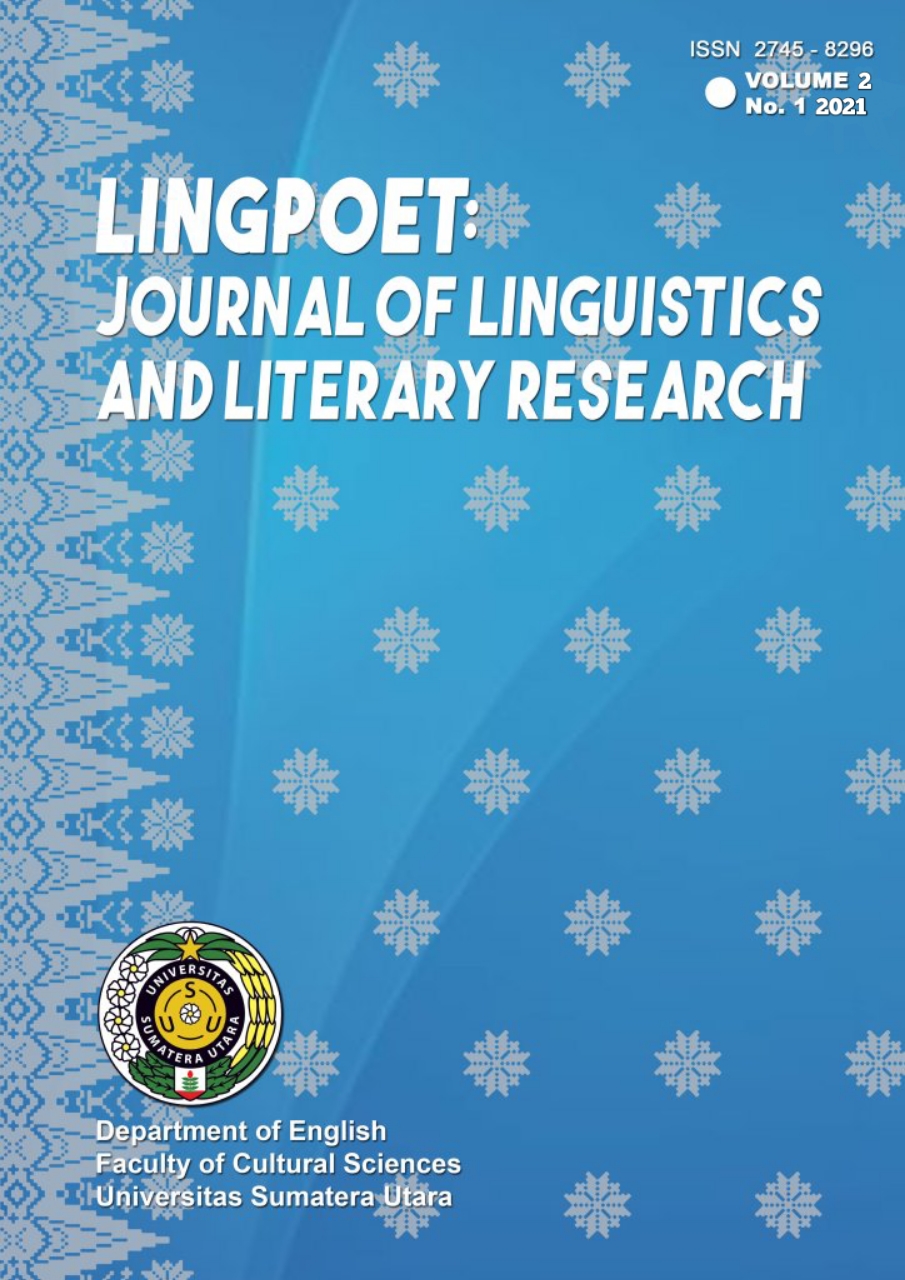A Visual Semiotic Analysis on the Spongebob Movie
DOI:
https://doi.org/10.32734/lingpoet.v2i1.5007Keywords:
Spongebob Movie, Sponge out of water, Visual semiotic, Pierce, Sign, MeaningAbstract
Visual Semiotics is a new semiotic branch that analyzes how visual signs or visual images convey messages. In visual semiotic, a sign can be a word, sound, or visual image. Spongebob Movie is one of category of visual semiotic. It consists of picture and subtitle on it. By using visual semiotic analysis, this research aimed to identify the sign found in the Spongebob movie: Sponge Out of Water and how it is interpreted. The Spongebob Movie: Sponge Out of Water as the data of the research are collected by using qualitative audio and visual materials from Spongebob.fandom.com as the source of the data. It is twenty nine data analyzed by using visual semiotic with the theory proposed by Charles Sanders Pierce. This research uses qualitative data analysis as the method of the study. Each data of the research consists of the sign and meaning. The signs was identified based on Charles Sanders Pierce triadic sign (Representament, Objet, and Interpretant) and there are three steps in interpreting the sign namely, non-verbal communication legisign, framing techniques and communicative act.
Downloads
References
Almohissen. Discursive and Visual Semiotic Analysis of Saudi Cartoons. Northeastern Illinois University: ProQuest Dissertations Publishing.2015
Ary, D et.al. Introduction to Research and Education. New York: Holt, Rinehart and Winston. 1979.
Broadbent, Goofrey. Design In Architecture. New York: John Willey and Sons.1980.
Chandler, D. Semiotics: The basic. New York: Rouledge. 2007.
Clandinin, D,J (ed). Handbook of narrative inquiry: Mapping a methodology. Thousand Oaks, CA: Sage. 2007.
Creswell, J.W. Research Method: Qualitative, Quantitative, and Mixed Methods Approaches Edition 4. London: SAGE. 2014.
Eco, Umberto. A theory of Semiotics.Kreasi wacana: Yogyakarta. 1979.
Harrison. “Visual social semiotics: Understanding how still images make meaning. Research Library. 2003.
F, Isnaini, B, Setyono, S, Ariyanto, “A visual semiotic analysis of multicultural values in an Indonesian English textbookâ€. Indonesiam Journal of Applied Linguistics, 8, 545-553. doi: 17509/ijal.v8i3.15253.2019.
Jappy, T. Introduction to Peircean Visual Semiotics. New Delhi: Bloomsburry. 2013.
Medlej, J. “Human Anatomy Fundamentals: Mastering Facial Expressionsâ€.2014, June 5. Retrieved from Design Tutplus: https://design.tutsplus.com/tutorials/human-anatomy-fundamentals-mastering-facial-expressions--cms-21140?_ga=2.190321259.1574346694.1546877615-623362627.1542085312 [Accessed: December 2019]
Miles, M.B, Huberman, A.M and Saldana, J.†Qualitative Data Analysis, A Methods Sourcebookâ€, Edition 3. London: Sage Publications. 2014.
Parsa, Alev FatoÅŸ.†Visual semiotics: how still images mean? Interpreting still images by using semiotic approachesâ€.Turkey: Ege university. 2009.
Peirce, C. S. Collected Papers of Charles S. Peirce (8 vols), C. Hartshorne, 1931–58.
Ramadhani. Emosi dasar dalam film (studi analisa semiotika dalam film animasi “inside outâ€). 2018.
Saussure, F.D. Cours de Linguistiquegenerale. Paris: Payot. 1983.
Sobur, Alex. Semiotika Komunikasi. Bandung : PT. Remaja Rosdakarya. 2003.
Sobur, Alex. Analisis Teks Media:Suatu Pengantar untuk Analisis Wacana, Analisis Semiotik, dan Analisis Framing. PT Remaja Rosdakarya: Bandung. 2004.
Sobur, Alex. Semiotika Komunikasi. Bandung : PT Remaja Rosdakarya. 2009.
Wekesa, Nyongesa Ben. Cartoons can talk? Visual analysis of cartoons on the 2007/2008 post election violence in Kenya: A visual argumentation approach. Discourse & Communication. 2012.
Downloads
Published
How to Cite
Issue
Section
License
Copyright (c) 2021 LingPoet: Journal of Linguistics and Literary Research

This work is licensed under a Creative Commons Attribution-ShareAlike 4.0 International License.













